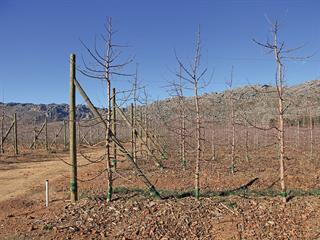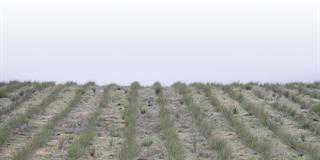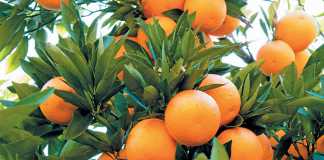
In the past, apple farmers were able to get away with paying less attention to the type of trellis systems they erected in orchards. However, orchards that follow the new trend of higher density in which trees are planted as close as 0,75m apart in the row, are less forgiving.
This is according to Willie Kotze, research and development manager at Dutoit Group. Kotze recently spoke at the Hortgro Science Symposium near Franschhoek on methods to extend the lifespan of a trellis system in a high-density apple orchard. Up till fairly recently, the main function of a trellis has been to support young trees in medium-density plantings. After a few years, the trees become less dependent on support.

Willie Kotze, research and development manager of Dutoit Group, shows the trials being undertaken on apple trees planted on different dwarfing rootstocks.
The trellises help the trees to reach their optimal height faster and prevent the development of basal dominance (vigorous side-shoots near the base). Trees with basal dominance require considerable inputs to boost leader growth and in some cases these trees never reach their full production potential.
According to Kotze, medium-density trees planted in a trellis system can produce up to 30% more fruit during the first five years than trees without support.
High-density planting and crop weight
With high-density planting, the trellis system has to support growth and be strong enough to support the crop weight during the productive life of the tree. Kotze explains that these trees develop trunks and branches that are too thin to support the crop, resulting in the need for a trellis system. In addition, trees planted on dwarfing rootstocks, such as M9, M26 and MM106, produce root systems that are not as strongly anchored as those of other more traditional rootstocks.
Long rows need strong anchors
As the end-post and anchors combination have to carry all the weight, Kotze advises farmers to consider soil type and row length when selecting a trellis system. In sandy soil, base plates should be larger than those used in heavier soil, and the longer the row, the stronger the anchor should be. Provision should also be made for wind impact, as the wind force can double the load on a system, according to a study by Cornell University in the US.
In South Africa, the box and slant brace are the two most popular anchoring systems. Farmers also use a slant and tieback combination. The box system is more expensive, because three poles are used in the anchor section, whereas only two are used in the slant brace, explains Kotze. While both worked well in the past with more vigorous rootstocks, Kotze feels that tie-backs will be better able to carry the weight in a high-density system.
“On less vigorous rootstocks, you cannot have trellises supporting trees halfway, as strain will damage the trees. They simply cannot support themselves.” It is calculated that trees will reach a height of between 80% and 100% of the distance between the rows in the orchard, which in this case, varies between 3,5m to 4m.
Searching for the right angle
According to research undertaken by New Mexico State University in the US, the strongest system is one in which the end-post leans away from the anchor wire at a 60° angle. In this way, both end-post and anchor wire carry the force. “If the pole is planted too upright, the load will become unequally distributed and this could result in the collapse of an anchor,” Kotze explains.
The longer the post, the greater the anchor pole’s diameter needs to be.“The anchor post should preferably have a diameter of more than 100mm. The pole should be sunk into the ground between 0,8m and 1m deep. By increasing the planting by a third, resistance to overturning is almost doubled,” he says.

A slant brace anchor is used here to support Early Red One on M7 rootstocks in a medium-density planting.
Previously, in-line posts (used inside the rows) had to support only the weight of young trees in medium-density plantings. In high-density systems they also serve as a counterweight. The poles should therefore not be planted further than 12m apart, and the distance between them should decrease as the rows become longer.
The diameter of the poles should be between 80mm and 100mm. Higher trees need thicker posts and upgrading the poles by a single class could increase stress resistance by as much as 40%, according to Kotze. Planting the poles deeper into the ground will also reduce the chances of their leaning sideways. The impact of the wind should also be taken into account when choosing poles and planning where to plant them.
Correct wire application
The total breaking strength of the wires used in the trellis – whether four or five – has to be equal to the breaking strength of the tie-back wires connecting the anchor to the end-poles. Various types of wire are available; Kotze recommends high tensile steel wire that does not stretch too easily. The yield strength (the point at which the wire will not return to its original length), and breaking strength of the wire need to be considered before an informed decision can be made.
For 2mm diameter wire, the range is 350kg and 500kg, depending on the type of wire used. As a rule of thumb, the wire should be tensioned to about 50% of the yield strength during construction. This will help to keep the wire from sagging once the crop is established.
The wire connected to the end-post should be taut, and not simply tied around the post; this will not provide any control over the tension required. Kotze emphasises that the leader support should not carry any weight, but only guide leader growth. It should be able to resist the wind and not slide along the trellis wire.
Staple requirements
Staples are used to affix the wire to the poles and end-poles. Most growers use the smallest staples they can find to save costs. However, this could lead to problems: the staples could be ripped out of the poles when the load becomes too heavy, causing the wires to sag. mIn addition, the staples should not be driven too deeply into a pole, as this will damage the galvanising of the wires and compromise the life-expectancy of the entire system. It could also cause stress points on the wire.
“Use a slash-cut points; it gives you a better grip when inserting the staples,” advises Kotze.
The staples should be placed at a 45° angle to split the grain. If you place them in a straight line, they will create a groove along the grain of the pole and pull out more easily.” The wire should also be installed on the upwind side of an in-line post to prevent the wind from pushing the wire away from the post. It is not a good idea to have a wire running at the top of the posts, as staples have very little grip on the pole-ends and the wires could cut into the posts.
Money well spent – if the job is well done
Kotze advises producers to budget properly when planning a trellis system of this nature, as it can increase the cost of establishing a new orchard by R60 000/ha to R70 000/ ha, which is about three times that of a conventional trellis system. However, he feels that improved quality, higher yield and reduced labour costs once the orchard is well-established, could make up for this, provided the job is done properly.
For more information. phone Dutoit Group on 023 312 3136.













